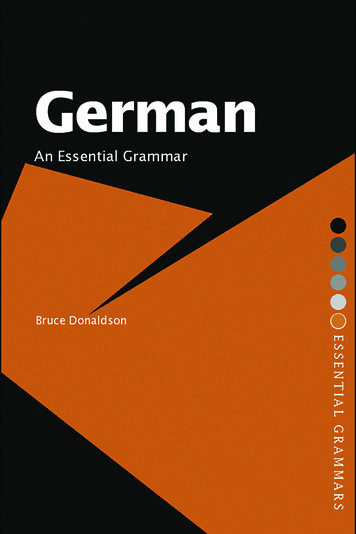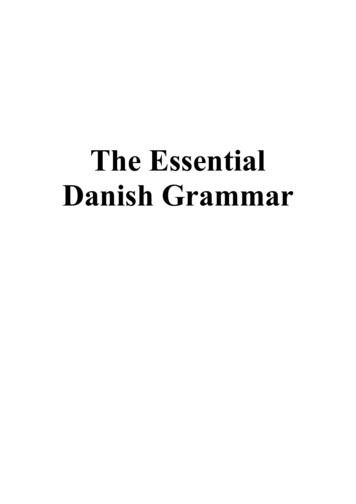
Transcription
The Praxis Study CompanionGerman:World Language(5183)www.ets.org/praxis
Welcome to the Praxis Study CompanionWelcome to the Praxis Study CompanionPrepare to Show What You KnowYou have been working to acquire the knowledge and skills you need for your teaching career. Now you areready to demonstrate your abilities by taking a Praxis test.Using the Praxis Study Companion is a smart way to prepare for the test so you can do your best on test day. Thisguide can help keep you on track and make the most efficient use of your study time.The Study Companion contains practical information and helpful tools, including: An overview of the Praxis tests Specific information on the Praxis test you are taking A template study plan Study topics Practice questions and explanations of correct answers Test-taking tips and strategies Frequently asked questions Links to more detailed informationSo where should you start? Begin by reviewing this guide in its entirety and note those sections that you needto revisit. Then you can create your own personalized study plan and schedule based on your individual needsand how much time you have before test day.Keep in mind that study habits are individual. There are many different ways to successfully prepare for yourtest. Some people study better on their own, while others prefer a group dynamic. You may have more energyearly in the day, but another test taker may concentrate better in the evening. So use this guide to develop theapproach that works best for you.Your teaching career begins with preparation. Good luck!Know What to ExpectWhich tests should I take?Each state or agency that uses the Praxis tests sets its own requirements for which test or tests you must take forthe teaching area you wish to pursue.Before you register for a test, confirm your state or agency’s testing requirements at www.ets.org/praxis/states.How are the Praxis tests given?Praxis tests are given on computer. Other formats are available for test takers approved for accommodations (seepage 48).The Praxis Study Companion2
Welcome to the Praxis Study CompanionWhat should I expect when taking the test on computer?When taking the test on computer, you can expect to be asked to provide proper identification at the testcenter. Once admitted, you will be given the opportunity to learn how the computer interface works (how toanswer questions, how to skip questions, how to go back to questions you skipped, etc.) before the testing timebegins. Watch the What to Expect on Test Day video to see what the experience is like.Where and when are the Praxis tests offered?You can select the test center that is most convenient for you. The Praxis tests are administered through aninternational network of test centers, which includes Prometric Testing Centers, some universities, and otherlocations throughout the world.Testing schedules may differ, so see the Praxis web site for more detailed test registration information at www.ets.org/praxis/register.The Praxis Study Companion3
Table of ContentsTable of ContentsThe Praxis Study Companion guides you through the steps to success1. Learn About Your Test.5Learn about the specific test you will be taking2. U nderstanding Question Types. 16Become comfortable with the types of questions you’ll find on the Praxis tests3. Practice with Sample Test Questions. 18Answer practice questions and find explanations for correct answers4. Determine Your Strategy for Success. 39Set clear goals and deadlines so your test preparation is focused and efficient5. Develop Your Study Plan. 42Develop a personalized study plan and schedule6. Review Smart Tips for Success. 46Follow test-taking tips developed by experts7. Check on Testing Accommodations. 48See if you qualify for accommodations that may make it easier to take the Praxis test8. Do Your Best on Test Day. 49Get ready for test day so you will be calm and confident9. Understand Your Scores. 51Understand how tests are scored and how to interpret your test scoresAppendix: Other Questions You May Have . 53The Praxis Study Companion4
Step 1: Learn About Your Test1. Learn About Your TestLearn about the specific test you will be takingGerman: World Language (5183)Test at a GlanceTest NameGerman: World LanguageTest Code5183TimeApproximately 3 hours, including the Listening Practice section and the optionalpractice with the built-in character toolbar for the Writing sectionNumber of Questions75 selected-response questions and 6 constructed-response questionsFormatListening Practice section (not scored). 6 practice selected-response questions ofthe type in the Listening with Cultural Knowledge section (10 minutes)Section 1. Listening with Cultural Knowledge; 36 selected-response questions(50 minutes)Section 2. Reading with Cultural Knowledge; 39 selected-response questions(50 minutes)Writing Practice (not scored). One practice constructed-response exercise usingthe built-in character toolbar (5 minutes)Section 3. Writing; 3 constructed-response tasks (50 minutes)Section 4. Speaking; 3 constructed-response tasks (15 minutes)Note: This test will include questions with an audio component in the Listeningand Speaking sections.Test DeliveryComputer deliveredContent CategoriesI.VIII.IVApproximateNumber ofQuestionsApproximatePercentage ofExaminationInterpretive Listening,30 selected responseincluding embedded linguistic content26%Interpretive Reading,30 selected responseincluding embedded linguistic content26%III. Cultural Knowledge(Tested in Sections 1 and 2)15 selected response12%IV. Interpersonal and PresentationalWriting3 constructed response(written)18%V. Presentational and InterpersonalSpeaking3 constructed response(spoken)18%IIIIIAbout This TestThis test is designed to measure the knowledge, skills, and abilities of examinees who have had preparationin a program for teaching German in grades K–12. Because programs in teaching German are offered at boththe undergraduate and graduate levels, this test is appropriate for examinees at either level. All sections of thistest are at the Advanced-Low level, as described in the proficiency guidelines of the American Council on theTeaching of Foreign Languages (ACTFL).The Praxis Study Companion5
Step 1: Learn About Your TestThis test integrates listening, reading, writing, andspeaking skills as well as linguistic and culturalknowledge through active participation in a variety ofquestions in the interpretive modes (in the Listeningand Reading sections) and in the interpersonal andpresentational modes (in the Writing and Speakingsections). The Listening and Reading sections of thetest are composed of selected-response questions,whereas the Writing and Speaking sections arecomposed of constructed-response tasks.All questions and answer choices are in German andare based on various genres of authentic material,whether written or in audio format, from variousGerman-speaking regions of the world.This is a computer-based test with sections of variouslengths and time constraints. All sections of the testare separately timed. While the time allotted in theReading and Writing sections is managed by thecandidate, timing is computer controlled throughoutthe Listening and Speaking sections. Before beginningthe Listening section, the candidate will participatein a practice exercise reflecting the type of questionsin the Listening section. Similarly, there is a writingpractice exercise before the Writing section toacquaint candidates with a special character toolbarthat they will be using to type their individualresponses in German.This test may contain some questions that do notcount toward your score.Discussion QuestionsInterspersed throughout the study topics arediscussion questions, presented as open-endedquestions or statements. These discussion areas areintended to help test your knowledge of fundamentalconcepts and your ability to apply those concepts tosituations in the classroom or the real world. Most ofthe areas require you to combine several pieces ofknowledge to formulate an integrated understandingand response. If you spend time on these areas, youwill gain increased understanding and facility with thesubject matter covered on the test. You may want todiscuss these areas and your answers with a teacher ormentor.Note that this study companion does not provideanswers for the discussion area questions, but thinkingabout the answers to them will help improve yourThe Praxis Study Companionunderstanding of fundamental concepts and willprobably help you answer a broad range of questionson the test.Content TopicsAn overview of the areas covered on the test, alongwith their subareas, follows.I.Content Categories I, II, IV, and V –Language, Linguistics, and Comparisons(88%)A.Demonstrating language proficiency inthe target language with native speakersunaccustomed to interacting withnonnative speakers, with sufficientaccuracy, clarity, and precision to conveyintended message (at the Advanced-Lowlevel, as described in the AmericanCouncil on the Teaching of ForeignLanguages [ACTFL] ProficiencyGuidelines)The beginning German teacher:1. Knows how to communicate in the targetlanguage with native speakers unaccustomedto interacting with nonnative speakers, withsufficient accuracy, clarity, and precision toconvey the intended message2. Knows how to communicate in theinterpersonal mode (speaking) byparticipating actively in informal and formalconversations on topics covering home,school, leisure activities, and current events3. Knows how to communicate in theinterpersonal mode (writing) in writtenexchanges on daily topics4. Comprehends in the interpretive mode(listening) main ideas and supporting detailsof audio segments such as news items, shortstories, social notices, and reports on familiartopics that deal with factual information5. Comprehends in the interpretive mode(reading) main ideas and supporting detailsof printed texts such as news items, shortstories, social notices, and reports on familiartopics that deal with factual information6. Knows how to negotiate meaning in order tosustain an interaction7. Knows how to move beyond literalcomprehension in the interpretive mode(listening) by inferring the meaning of6
Step 1: Learn About Your Testunfamiliar words and phrases in newcontexts, inferring and interpreting theauthor’s intent, and offering a personalinterpretation of the message6. Knows how to identify and use the pragmaticand sociolinguistic conventions and register(formal and informal forms of address)C.8. Knows how to move beyond literalcomprehension in the interpretive mode(reading) by inferring the meaning ofunfamiliar words and phrases in newcontexts, inferring and interpreting theauthor’s intent, and offering a personalinterpretation of the messageThe beginning German teacher1. Knows how to identify similarities anddifferences between the target language andEnglish2. Knows how to contrast syntactical patterns ofsimple sentences and questions with those ofEnglish9. Understands the gist of normalconversational speech on a variety of topics10. Knows how to communicate in thepresentational mode (writing) by writingroutine social correspondence as well ascoherent narratives, descriptions, andsummaries about familiar topics of a factualnature in paragraph length in present, past,and future time11. Knows how to communicate orally in thepresentational mode (speaking) by deliveringoral presentations on familiar literary orcultural topics and incorporating extralinguistic support to facilitate oralpresentations that are extemporaneous orprepared but not readB.Comparison of target language withEnglishII.Content Category III – Cultures,Literatures, and Cross-disciplinaryConcepts (12%)A.Demonstrating cultural understanding—connections among the perspectives ofthe target culture and its practices andproductsThe beginning German teacher1. Knows the three Ps:a.perspectives (such as attitudes, ideas,and values)b.practices (patterns of behavior and socialinteraction, such as greetings, turntaking, and rites of passage)c.products (such as foods, architecture,literature, art, and music)Understanding linguistics—linguisticfeatures of the target languageThe beginning German teacher1. Understands the rules of the sound system ofthe target language (i.e., recognizingphonemes and allophones)2. Recognizes key cohesive devices(conjunctions and adverbs) used inconnected discourse3. Understands high-frequency idiomaticexpressions and can infer the meaning ofwords and sentences4. Knows how to explain the rules that governthe formation of words and sentences in thetarget language5. Knows how to exemplify the rules withexamples from the target language, such asthe verbal system, pronouns, agreement(such as subject/verb, adjective/noun), wordorder, and interrogatives, both in terms ofregularities and irregularitiesThe Praxis Study Companion2. Recognizes the value and role of authenticliterary and cultural texts—such as songs,poems, rhymes and chants, children’s books,narrative text, and novels—and usage ofthose texts to interpret and reflect on theperspectives of the target culturesTest SectionsThe Listening Practice section, Section 1 (Listening)and Section 4 (Speaking) all require playback of prerecorded audio material. For Section 4, you must alsoprovide spoken answers to questions when instructedto do so on the recording.Listening Practice Section - InterpretiveListening with Cultural KnowledgeThis section allows you to listen to an audio selectionin German and to practice answering questions7
Step 1: Learn About Your Testbased on that selection in the time allotted. ThisListening Practice section is timed separately fromthe Listening section that follows, and the time youspend practicing will not be counted toward the timeallotted to answering the questions in the Listeningsection. The questions in this section will NOT bescored and will NOT affect your results in any way.Section 2 - Interpretive Reading withCultural KnowledgeThe selections in Section 1 are recorded.In this section, you will be presented with a varietyof selections, such as newspaper articles, excerptsof literary passages, and other materials, in German.Each selection is followed by six questions. The lasttwo questions may test your knowledge of cultureand linguistics. In addition, you will be presented withsome visual stimuli (e.g., photographs or works of art),each accompanied by a single cultural knowledgequestion.In this section, you will hear a variety of selections,such as radio broadcasts, narratives, and dialogues, inGerman. Each selection is followed by six questions.You may take notes as you read, but only on thescratch paper that will be provided. Your notes will notbe graded.Each selection will be played twice. You will hearthe selection and then you will have 60 seconds topreview the questions before the selection plays asecond time. For each question, choose the responsethat is best, relative to the selection. The last twoquestions may test your knowledge of culture andlinguistics. You may take notes as you listen. Yournotes will not be graded.Each of the questions is followed by four suggestedanswers. Select the one that is best in each case.Section 1 - Interpretive Listening withCultural KnowledgeAfter listening to a selection the second time, you willsee six questions presented one at a time. You willhave 20 seconds to answer each question. A clock atthe top of the screen will indicate how much time isremaining to answer the question. The entire Listeningsection lasts approximately 50 minutes.When the response time has ended, you willautomatically be taken to the next question. You willnot be able to return to previous questions.Discussion questions: Interpretive Listening What register is used in this spoken segment? Isthe form of address formal or informal? Do theword choices imply an audience that is familiarwith popular culture, youth slang, academicbackground, or perhaps bureaucracy? What regional variations can be detected in thisspoken segment? Do they correspond to a majordialectical form such as Bavarian, Saxon, Swiss, orLow German? How are the details in the segment connected tothe main idea? Does the speaker give an examplein order to support an argument? Is an authorityon the subject cited or allowed to provide a pointof view?The Praxis Study CompanionDiscussion questions: Interpretive Reading What is the genre of the text: is it a promotionalmaterial designed to motivate the reader to buy ordo something? A piece of literature that sets up afictional world? An academic analysis? A newsreport? How is the genre reflected in the impliedaudience and in the structure of the text?Linguistic KnowledgeQuestions that test your knowledge of the linguisticstructures of German are included along with thecontent questions for each selection in the Listeningand Reading sections. Keep in mind that linguisticknowledge questions are posed in German, as are allother questions. You will not find the answer to thesequestions directly in the selections, but will need torely on your knowledge of the German language torespond.The following list may be helpful in your preparationfor the linguistic knowledge component of the test,but please keep in mind that this is to serve as a guideand is not intended to be an exhaustive description ofGerman grammar and language use: Understanding the rules of the German soundsystem (i.e., recognizing phonemes andallophones) Recognizing key cohesive devices (conjunctionsand adverbs) used in connected discourse8
Step 1: Learn About Your Test Understanding high-frequency idiomaticexpressions and inferring meaning of words andsentences Understanding the rules that govern the formationof words and sentences in the target languageIn particular, you should be acquainted with thefollowing concepts and their application in German: Strong and weak verbs in the various tenses Verbs in infinitival clauses Modal auxiliaries Word order in main and subordinate clauses The use of the subjunctive or the indicative mood The use of verbs in the passive voice and alternativesto the passive voice Noun-adjective agreement The marking of gender, case, and number by meansof articles; also the declination of weak nouns Negation Placement and use of direct and indirect pronouns The correct use of prepositions, including two-wayprepositions The correct use of articles for time expressions, date,season, etc. Formation of comparatives and superlatives The correct use of flavoring/emphasis words Certain German grammar constructs that differ fromEnglish, e.g.,–– Ich interessiere mich für Musik. (“I am interested inmusic.”)–– Ich habe mir den Arm gebrochen. (“I broke my arm.”)Discussion questions: Linguistic Knowledge What are the important connective structures thatlink clauses and sentences together? In particular, canI determine the antecedents to pronouns and relativepronouns? How could I explain the basic subject-verb-objectstructure of a given sentence to a student? Whatwould help students identify that structure?The Praxis Study CompanionSection 3 - Cultural KnowledgeThe culture questions are in German and are part ofSection 1 (Listening) and Section 2 (Reading).Questions in the Cultural Knowledge reportingcategory require you to be able to recognizeimportant products (such as architecture, literature,art, foods, and music), practices (patterns of behaviorand social interaction such as greetings, turn taking,and rites of passage), and perspectives (such asattitudes, ideas, and values) of German-speakingcultures. Questions in this reporting category will becontextualized by reference to a recording, a passage,or an image. Memorization will not be required; rather,the questions will call for an understanding of culturalinferences, trends, and general concepts related toselections or images.Questions in the Cultural Knowledge reportingcategory are of two types.Most will be one of a group of six questions basedon each Listening or Reading selection. They will usesome aspect of the selection as jumping-off pointsto test your knowledge of cultural implications ofthe selection. For the most part, you will not find theanswer to these questions directly in the selections,but the question will be related to the selection itfollows.There will also be standalone Cultural Knowledgequestions based on an image that has importance inGerman-speaking cultures. This might be a picture ofan important monument or event, or a well-knownpainting related to some aspect of German culture.In general, these questions will touch on lifestylesand societies, sociolinguistic elements of German,literature and the arts, history, and geography; like theselections themselves, they will include materials onmany areas of the German-speaking world.The following is a suggested list of topics that mayappear in the Cultural Knowledge segment of the testThis list is in no way comprehensive, but it providesan idea of the type of topics related to the Germanspeaking culture that may appear in the test.Lifestyles and SocietiesIn these questions, your knowledge of the way oflife and customs in Germany and in other Germanspeaking countries and regions will be tested.9
Step 1: Learn About Your Test Contemporary lifestyles Food Social behaviors and customs Navigating everyday infrastructure andbureaucracy Commonly celebrated religious and publicholidays Family relationships Vacations Education Regional variations Significant figures, works, and trends in theperforming arts (music, theater, dance, film).Examples: Mozart, Beethoven, dramas by Goethe,Kleist, or BrechtHistoryIn these questions, your knowledge of the historicalfacts and background of Germany and Germanspeaking countries and regions will be tested. Thisincludes: Major periods of the history of Germany, Austria,Switzerland, and Liechtenstein Contributions of German culture to North AmericaSociolinguistic Elements of GermanThese questions test your knowledge andunderstanding of appropriate language andexpressions. Based on the language in a selection, itmay require you to make inferences regarding socialsituations or the audience. Customary usage of certain words or expressionsto indicate register, such as the use of Sie asopposed to du Most important events and principal historicfigures of Germany and other German-speakingcountries Contemporary world politics and economics asthey affect German-speaking countries Relations with other EU countries Immigration issues German economy, business, and industry Use of colloquial language Idiomatic expressions; common sayingsLiterature and the ArtsFor these questions, you should acquaint yourselfwith the most commonly known works, authors, andtrends of literature from Germany and other Germanspeaking countries. Major trends, periods, and movements in Germanliterature. Examples: Sturm und Drang, Romantik,Expressionismus, Trümmerliteratur, Die Moderne Significant figures, works, and trends in the plasticarts (painting and sculpture). Examples: Klimt,Dürer, KirchnerGeographySometimes a culture question may involve locatingGermany and other German-speaking regions andcountries or identifying major geographical featuressuch as major cities, rivers, or mountains in Europe.Once again, test takers are reminded that these aresimply areas, topics, events, and figures that representthe major categories that are covered.Discussion questions: Cultural Knowledge Does the text describe, locate, or evaluate aphenomenon by means of historical or culturalcomparisons or contrasts? Architecture in German-speaking cultures.Examples: Gothic and Baroque architecture,Jugendstil, BauhausThe Praxis Study Companion10
Step 1: Learn About Your TestSection 4 - Interpersonal and PresentationalWriting Accuracy of grammar and mechanics (includingspelling and diacritical marks)There are three tasks in this section. Be sure tocomplete each task. Please pace yourself as you work. Cohesiveness (including use of varied sentencestructure and transitional expressions, whereappropriate)The section allows you to practice typing in yourwritten constructed-response answers in German. Youwill see a field for entering your response. For Germanspecific characters (e.g., ä,ö,ü,ß,etc.) use the builtin character toolbar (click here to view a demo of thetoolbar). You should give as complete a response aspossible. Your written German should be acceptableto a wide range of native speakers. Appropriateness for a given task and/or reader(register)Note: To run the built-in character toolbar tutorial from thepreceding link, you need Java Runtime Environment version8u281 installed on your computer. If you do not have JavaRuntime Environment version 8u281, you can downloadit for free or you can visit the Java website to install it. Toavoid issues with the download, be sure to uninstall all Javaversions in your system and reboot your computer beforedownloading version 8u281. When you click on the tutoriallink below, a security prompt asks you to allow the programto run. This is normal. The toolbar tutorial runs the sameversion of Java that is on the actual test to ensure that thetutorials accurately reflect the testing experience. When theprompt appears, click Allow (or Keep).Additionally, if your security settings are set very high, asecond security prompt asks you to run the application.Again, this is normal. When this prompt appears, click Run.If you are unsure if your computer has Java RuntimeEnvironment version 8u281, navigate to Start/ControlPanel/Java. From the Java Control Panel popup window,select the Java tab, then the View button. The Java RuntimeEnvironments Setting window displays the currentlyinstalled versions of Java.You may use the scratch paper that will be providedto take notes on each task. These notes will not beused in evaluating your response.Your writing will be evaluated on the following: Overall comprehensibility to a native speaker ofGerman who is not accustomed to the writing ofnonnative learners The extent to which each task is completedInterpersonal Writing: Response to anE-mail, Memo, or LetterYou will be given an e-mail, memo, or letter to whichyou will write an appropriate response in German.First, read the e-mail, memo, or letter. Then, write yourresponse in the space provided.Manage your time to allow for planning, writing, andrevising your response. The length of your responseshould be at least 60 words.Presentational Writing: Opinion/PositionEssayYou will be asked to write an essay in German on aspecific topic. First, read the topic. Then, write yourresponse in the space provided.Make sure that your essay includes reasons and/orexamples to support your opinion.Manage your time so that you have enough time toplan, write, and revise your response. The length ofyour response should be at least 120 words.Presentational Writing: Integrated SkillsYou will read a passage in German. This passage willappear in both the Writing and the Speaking sections.After reading the passage, you will complete a writingtask based on the passage. Your response must bewritten in German. Write your response in the spaceprovided.Manage your time to allow for planning, writing, andrevising your response. The length of your responseshould be at least 120 words. Accuracy and appropriateness of content Presentation of ideas in a related and logicalmanner Appropriateness of vocabularyThe Praxis Study Companion11
Step 1: Learn About Your TestSection 5 - Presentational and InterpersonalSpeakingThis section includes three tasks and is designed tomeasure different aspects of your ability to speakGerman.These tasks are designed to elicit responses thatdemonstrate how well you speak German. Thereare three different questions, and specific directionswill be given for each one. Although you need notspeak for the entire time allotted, you should give ascomplete a response as possible.For each speaking task in the test, you will be giventime to prepare your response and time to recordyour response. A tone will indicate when to beginspeaking, and a clock on your screen will indicate howmuch time you have left. Begin speaking only whenthe voice on the recording directs you to respond; youwill not be given credit for anything recorded duringthe preparation time. As you speak, your response willbe recorded. Your score for these tasks will be basedonly on what is on the recording. It is important thatyou speak loudly enough and clearly enough into themicrophone.Your speaking will be evaluated on the following: Overall comprehensibility to a native speaker ofGerman who is not accustomed to interactingwith nonnative speakers Accuracy and appropriateness of the content Presentation of ideas in a related and logicalmanner Appropriateness of vocabulary Accuracy of grammar and pronunciation Fluency of delivery and cohesiveness (includinguse of varied sentence structure and transitionalexpressions, where appropriate) Appropriateness for a given task and/or listener The extent to which each task is completedIf you do not know specif
German: World Language (5183) Test at a Glance Test Name German: World Language Test Code 5183 Time Approximately 3 hours, including the Listening Practice section and the optional practice with the built-in character toolbar for the Writing section Number of Questions 75 selecte










